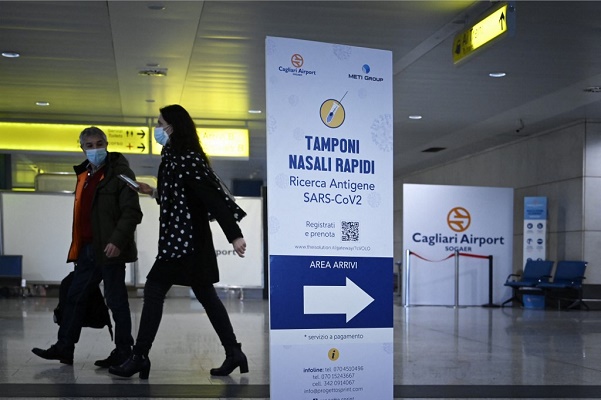Italy: What are the rules for travel over Easter?

Passengers walk in the arrival area of Cagliari's airport, on March 15, 2021. - Sardinia is the only Italian region designated as low-risk and escaping Covid-19 restrictions. (Photo by Alberto PIZZOLI / AFP)
Rome: Italy is tightening its rules across the country at Easter – but there are a few exceptions. Here’s what you need to know if you’re hoping to travel over the holiday weekend.
Italy’s rules for international travellers remain the same: visitors from other EU countries or the Schengen Zone are allowed to come to Italy for tourism or any other reason, provided they test negative for coronavirus no more than 48 hours before arrival. Anyone without proof of a negative antigen or PCR test must quarantine for 14 days.
There are different rules for people travelling from Austria, who are subject to testing on arrival as well as before departure, and have to spend two weeks in quarantine even after two negative test results. They must then take a third test after 14 days. The rules apply until at least April 6th: find full details on the Italian Health Ministry’s website (in English).
Visitors from a handful of low-risk countries outside the EU – Australia, New Zealand, Rwanda, South Korea, Singapore and Thailand – are also allowed to come to Italy as tourists, though they must quarantine for 14 days on arrival.
Italy currently has extra restrictions on the UK and Brazil. People departing from Great Britain or Northern Ireland are only allowed to enter Italy if they were officially registered as residents before December 23rd 2020 or can prove they need to come for “reasons of absolute necessity”. They must get tested before and after arrival, and carry out 14 days’ quarantine regardless of the results.
Meanwhile travellers from Brazil must have been registered residents before February 13th 2021, be returning to minor children living in Italy, or have other essential reasons to travel. They have to get tested before and after arrival, observe quarantine, and get tested again after 14 days.
Travellers from the rest of the world, including the United States, Canada, India, Russia, China and every other country unless specified, can only visit Italy for essential reasons, such as for work or study or to get medical treatment.
Nationals of other countries who live in Italy, as well as Italian or EU nationals and their family members, are allowed to return to Italy, but they have to quarantine for 14 days. The same applies to people who have “a proven and stable emotional relationship” with a legal resident of Italy and need to reach their partner’s Italian home.
Find more details of Italy’s current travel rules, including exceptions for people travelling for work or transiting briefly through Italy, on the Ministry of Health’s website (in English).
Yes – so long as your chosen destination allows you to enter, and you’re aware of the rules that will apply to you on your return to Italy (see above: residents of Italy are subject to the same testing and quarantine requirements as tourists).
The Italian Interior Ministry recently confirmed that people in Italy are free to depart on holiday to other countries within the EU or Schengen Zone, even if it means travelling within Italy to reach the airport or ferry terminal. That stands even when Italy is a nationwide ‘red zone’ over the Easter weekend, with strict limits on leaving your town or region under most other circumstances.
However, Italy’s Foreign Ministry continues to recommend that people avoid travelling abroad unless “strictly necessary”, including within the EU. New restrictions on entry to Italy from other countries are possible and could lead to difficulty getting home, the ministry warns.
Italy currently has a ban on most travel between regions, which is only allowed for work, health or other emergencies.
With all regions either red or orange zones under Italy’s tier system of risk-assessed restrictions, non-essential travel between towns is also banned.
Over the Easter weekend from April 3rd to 5th, the whole of Italy will become a red zone with maximum restrictions in place, amounting to a form of lockdown.
Under these rules, people are required to stay at home except for essential reasons, including buying groceries, going to work or exercising (by yourself).
If you need to make a trip either within your own town or beyond it, you should be prepared to fill in a self-declaration form justifying your reasons.
Transport including trains and buses continues to operate for people who need to travel, but may be running a reduced schedule. You’re also likely to have your forms checked by police at train stations and bus terminals. If you’re driving, you’ll also be subject to police stops on the road.
It depends. If you live overseas and have a holiday home in Italy, you will need to follow the same travel restrictions as any other visitor (see above).
If you live in Italy and have a second home within the country, the national rules do allow you travel there. You can return to a home in a different town or region even if it’s not your permanent residence and even if it means leaving a red or orange zone.
But there are two conditions: you must have owned or rented the property before January 14th 2021, and there can’t be anyone else already living there. In other words, you can’t decamp to a short-term rental, or stay with friends or relatives.
Remember too that certain regions of Italy have introduced their own restrictions limiting visits from second-home owners over the Easter break, including Tuscany, Sardinia, Valle D’Aosta and Alto Adige/South Tyrol. These take the form of local ordinances that you can find published on each region’s official website: find links here.
You can’t go and stay with your loved ones, as explained above. But you can spend the day with them, according to a special exception on socializing in Italy’s Easter rules.
Over April 3rd to 5th, when Italy is a red zone, you will be permitted to visit another nearby household once a day, and accompanied by no more than one other adult (though children under 14 can come too).
You must stay within your own region and should set off after 5am and return home by 10pm, in line with Italy’s nightly curfew.
Such visits are usually banned in red zones, but the latest emergency decree contains a temporary allowance for the holiday weekend.
Italy’s current emergency decree came into force on March 6th and will remain in place until April 6th.
The Italian government has not yet confirmed the rules from April 7th onwards, though Prime Minister Mario Draghi has indicated that the tier system of regional restrictions will remain in place and that none of Italy’s regions will become a yellow or white zone – where restrictions are allowed to loosen – until at least the end of April.





